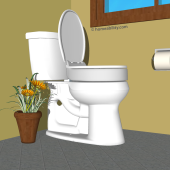Best Type of Toilet for a Wheelchair User
What is the best toilet for a wheelchair user? The answer to this will depend on the size of the bathroom, structure of the bathroom’s walls, type of wheelchair used, and physical needs of the individual.
We have identified a list of the top six toilet types for wheelchair users and the benefits associated with each type.
1. Wall Hung Toilet Bowl With Concealed Tank
If you are a wheelchair user and have a small bathroom, a wall-hung toilet bowl with the water tank concealed inside the wall is ideal. This toilet type has potential to help you gain up to as much as 18 inches of valuable clear floor space to help make maneuvering inside the bathroom with your wheelchair easier. This 18 inch gain in floor space takes into account a combination of the following:
- Concealed Water Tank: When the toilet’s water tank is concealed inside the wall, most people can gain an average of 9-12 inches of clear floor space in front of the toilet bowl.
- Space Under Toilet Bowl: If you use a manual wheelchair, the wheelchair’s footrests can usually pass underneath the toilet bowl, thereby increasing usable clear floor space by an average of 6 inches. If your wheelchair has elevated leg rests, however, it is unlikely they will pass underneath the toilet bowl, so this space would not be usable.
Wall Mounted Toilets on Amazon.com
2. Pedestal Toilet With Tank Concealed Inside Wall
If the wall of your bathroom isn’t structurally strong enough to support a wall-hung toilet, consider a pedestal-style toilet with a water tank concealed inside the wall. Also known as a “back to wall” toilet because your back will rest against the wall (not against a toilet tank) when you are seated on the toilet. Since the tank is concealed inside the wall, you have potential to gain an average of 9-12 inches of clear floor space in front of the toilet bowl. The pedestal base, however, will prevent the footrests from passing underneath the bowl, so you won’t be able to make use of the floor space present underneath the bowl as you can with a wall-hung style toilet. If you intend to replace an existing pedestal toilet with tank, with a back-to-wall toilet, the plumbing in the floor will need to be adjusted so the pipes line up with the new toilet.
Floor Standing Back to Wall Toilet Amazon.com
3. Wall Hung Toilet Bowl & Tank
If structural barriers inside the bathroom wall prevent you from installing a toilet tank “inside” the wall, consider one of the wall-hung toilet models in which both the bowl and the tank both get fixed to the outside of the wall. Since the tank is present inside the bathroom (not inside the wall), you won’t gain floor space in front of the toilet. However, with the tank and bowl both suspended from the wall, you can benefit from the clear floor space present underneath the toilet bowl, which can increase clear floor space by an average of six inches “if” your wheelchair doesn’t have elevated foot rests.
Wall Mounted Toilet Bowl & Tank Amazon.com
4. ADA Height Toilet
If you have a large bathroom, and floor space is not an issue, a standard-style toilet (with a pedestal base and tank attached to the back) that is classified as being an “ADA Height” toilet is another good option. What is an ADA height toilet? The acronym “ADA” stands for the Americans With Disabilities Act, which requires toilets installed inside the handicap stalls in public facilities to have a higher-than-average toilet seat height; namely, they must be 17-19 inches, measured from the floor to the top of the toilet seat. This height range is deemed to generically work best for the greatest number of wheelchair users, because the height of many wheelchair seats also fall within a similar height range. When the toilet seat and wheelchair seat are similar in height, it makes it easier to transfer back and forth between the two surfaces.
While a seat height of 17-19 inches may work well for the majority of wheelchair users, it is important to note it does not work for all wheelchair users. To learn more about choosing the right toilet seat height for your needs, click here.
Comfort Height Toilets Amazon.com
5. Motorized Adjustable Height Toilet
A toilet lifter bracket can be attached to your bathroom wall and to the toilet, which allows the entire toilet to be adjusted up/down in height with the push of a button. Special, flexible plumbing must be installed to make this possible. Power-assisted, height-adjustable toilets are a consideration for persons who have difficulty standing up independently, persons who require a higher-than-average height toilet, or in cases where multiple people live in the home who vary significantly in height (i.e. one person uses a wheelchair and the other person is 6’8″ tall.)
6. Toilet Bidet Combo
If you have trouble wiping yourself, consider a toilet-bidet combo. In the past, a bidet was always a separate bathroom fixture from the toilet. Nowadays, toilets exist that dual as both a toilet and bidet. With the push of a button, a wand emerges from inside the toilet and releases a steady stream of water, making it possible to cleanse the genitals and anus after using the toilet, without needing to use toilet paper. If you are having trouble with constipation (often a consequence of reduced mobility skills), consider a model that includes an enema-like water stream as an optional feature.
Alternatively, a bidet-style “toilet seat” can be added to standard toilet bowl to create a bidet-toilet combo. To learn more about bidet-toilets click here.
Bidet Toilet Combo Amazon.com
Things to Consider When Picking a Toilet Type
- Toilet Bowl Depth: Wall-hung toilets come in a variety of sizes and shapes. If you are considering a wall-hung style toilet and anticipate using the clear floor space below the toilet bowl to make moving and turning around inside the bathroom easier, then make sure to pick a toilet model that doesn’t have an overly deep bowl, so there will be plenty of space for the footrests to pass underneath the bowl.
- Toilet Bowl Height: The toilet’s seat height can play an important role in how comfortable you’ll be while seated on the toilet, and how easy it will be for you to transfer on and off the toilet. Toilets with a pedestal-style base can be ordered in pre-fixed heights. A wall-hung style toilet will allow for greater flexibility in selecting the right height for your needs. To learn more about choosing the right toilet seat height for your needs, click here.
- Toilet Bowl Shape: Many (but not all) people feel a toilet bowl with an elongated shape (oval or rectangular) is more comfortable than a compact-sized bowl (round or square). A benefit, however, for a smaller bowl is that you can gain on average another two inches of space in front of the toilet bowl. To learn more about choosing the best toilet bowl shape for you, click here.
- Wheelchair Leg rests: If you have a small bathroom and a standard-style wheelchair with standard-height footrests, you can benefit from the space underneath a wall-hung toilet, because (as we noted above) the footrests can pass underneath the bowl when you are turning around. Even if your bathroom is large, a wall-hung style toilet is typically preferable to a pedestal-style toilet, because you don’t have to worry as much about your footrests banging into or scraping the toilet, which can happen with a pedestal base. If your chair has elevated-height leg rests, however, it doesn’t matter if you choose a wall-hung model or a model with a pedestal, because the space below won’t be accessible.
- Weight Capacity: Due to government regulations, toilet products typically cannot be returned. Confirm the toilet’s weight capacity will support your needs, prior to ordering.
- Mechanical Parts: Keep in mind that toilets with mechanical parts, such as the bidet-toilets and the motorized, height adjustable toilets, will require periodic maintenance.
- Cost of Installation: Floor-mounted toilets will usually cost on average $200-$500 to purchase and have installed. A wall-hung toilet can cost on average $1,500-$2,000 to purchase and have installed. Wall-hung toilets cost more, because there are more parts to purchase and it takes more time to install the support frame inside the wall and/or to reinforce the existing walls. Bidet-Toilet Combos cost on average $1,600-$4,000.
- Aesthetics: Wall-hung toilets are more commonly visible in public restrooms in the USA, than in private homes. Notably, the models installed in public restrooms don’t tend to be overly attractive. Don’t let this scare you off! Plenty of elegant, sleek, modern-style wall-hung toilet models are available for use in private homes.
The Homeability Advice™ 
If you have a tiny, cramped bathroom, a wall-hung toilet with a concealed water tank will help you to gain the greatest amount of usable clear floor space. The drawback is that a wall-hung toilet is usually more expensive and takes more time to install than a floor-mounted toilet because the wall’s support structure often needs to be modified, and the wall needs to be refinished at the end. It is easiest to install a wall-hung at the time of a full bathroom remodel, when the wall studs are still exposed.
If you have a tiny, cramped bathroom and you have financial constraints, the back-to-wall style toilets are a good compromise. They will help you to conserve space because the water tank is concealed inside the wall, but cost less because the wall doesn’t need to be reinforced to support the weight of the toilet bowl (and you).
Most people do just fine with either a fixed-height pedestal-style toilet or a wall-hung style toilet, but if you have unusual needs, or there is only one toilet in the home and the users are extremely varied in height, then a motorized, height-adjustable toilet may be worth a consideration.
Related Topics
- “I Have Difficulty Wiping Myself!”
- “I Can’t Get Up From the Toilet!” 10 Remedies
- Accessible Toilets & Toilet Equipment: The Basics
- What’s the Best Toilet Height?





